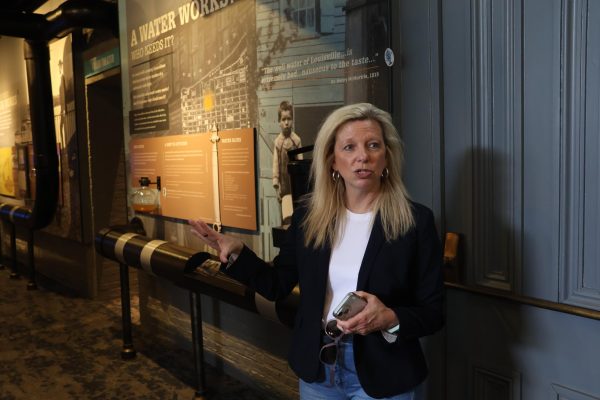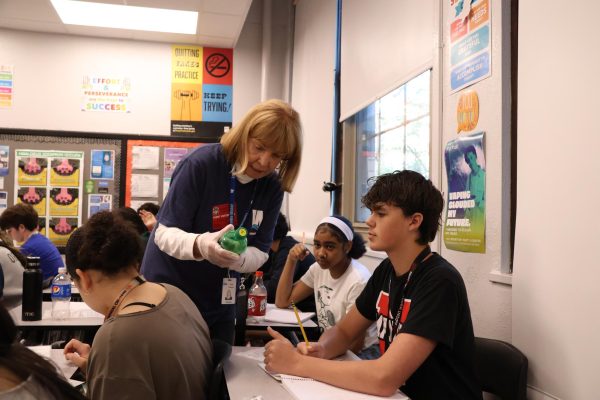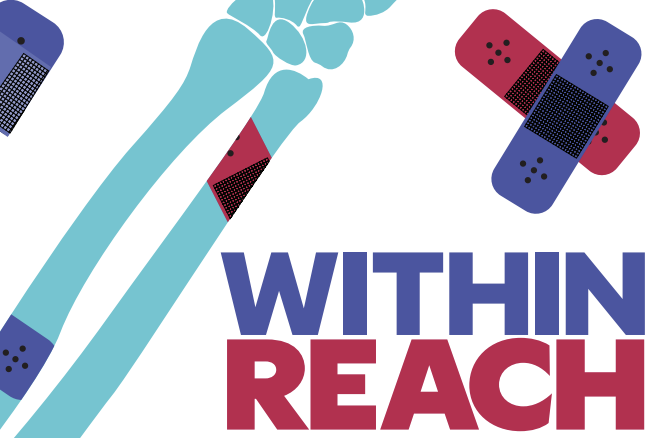The currents of the Ohio River, steady and slow-moving, reflected soft hues of sunlight. The gentle ripples of water mirrored a grand silhouette — not a person, rather a tower, looming over the riverbank.
At the structure’s base, a perfect ring of ornate white columns created a circle. Moldings adorned the surface and ten zinc statues stood upon pedestals, overlooking visitors and a sleek black sign with gold lettering reading “Louisville Water Company Landmark.”
The tower was conspicuous: grandeur in its design and history. Every part of the building and its neighboring river traced back to one unifying initiative: to deliver clean, high-quality water for the community.
What’s in the Water?
Despite the increase in water treatment systems across the nation, drinking water continues to be of poor quality in many states.
According to the U.S. Environmental Protection Agency (EPA), drinking water can make up to 20% or more of a person’s total exposure to lead, which can be destructive to an individual’s health in certain amounts.
With this exposure, adults may suffer from high blood pressure, problems with memory and concentration, reproductive issues and muscle and joint pain.
Lead exposure may also cause a range of other severe health impacts, including learning disabilities, hearing problems, stunted growth and even damage to the brain and nervous systems.
Alarmingly, children are more vulnerable to lead exposure because their bodies are still developing, allowing for more efficient lead absorption.
Due to this heightened vulnerability, educating youth about water treatment, safety and lead awareness is critical.
Lead contamination has the potential to expose millions to dangerous levels of toxic metals and particulates, and the water that we use for drinking, personal hygiene and cleaning dishes allows for just that.

The lead crisis disproportionately affects lower-income families, specifically people of color. Due to racial residential segregation, Black and Hispanic individuals have historically been subject to living in older, lower quality areas. Limited resources for remediation cause higher rates of lead poisoning in these neighborhoods.
Despite these implications, the crisis only began gaining national attention in 2014 following the water contamination in Flint, Michigan. After a switch in their municipal water source, improper water treatment caused severe lead poisoning in almost 100% of the city’s residents.
Flint is just one example — millions of people nationwide continue to face similar risks.
In January, the EPA estimated that about nine million water service lines still contain a harmful amount of lead.
However, in December of 2024, the EPA issued a new lead regulation rule that provided stricter provisions water systems must closely adhere to. The rules mandated that water systems are required to replace all lead service lines and maintain lead concentrations below a harmful threshold.
While the U.S. continues to make changes to combat the lead exposure crisis, the Louisville Water Company (LWC) consistently works to transform and improve the state of the nation’s water quality for future generations — one cup at a time.
Serving the City
LWC has implemented water quality treatment and research that stands out. In response to the national lead crisis, the company reduced the number of lead service lines substantially.
In 2020, LWC also finished removing and replacing all public lead service lines that they’d installed from 1860 to 1936 — about 74,000 in total.
“We are one of a few water utilities in the United States that have been extremely progressive in eliminating lead service lines,” Kelley Dearing-Smith, the vice president of communications at LWC, said.
This replacement is drastic in comparison to the rest of the U.S. According to the EPA, lead service lines are estimated to make up over 9% of national service line infrastructure.
Currently, LWC is focused on aiding a small number of customers, less than a few thousand, who have lead service lines on their private property. The corporation is working on a one-on-one basis to make sure pipes are effectively removed.
“We’re actually paying to replace it for them. It goes back to that idea of water quality,” Dearing-Smith said. “We take that very, very seriously.”
The company effectively deals with other crises as well — especially unpredictable ones.
From April 2-6, waves of severe storms brought heavy rain throughout Southern Indiana and Central Kentucky, causing widespread flooding. This flooding reached near record-breaking levels, as the Ohio River crested at just under 37 feet.
In response, LWC employees worked 24-hour shifts at the water pumping stations, being transported in boats to provide clean water for Louisville’s constituents. With the changing water levels, the company adjusted water treatment to remove harmful particles and bacteria seeping in.
LWC’s response to the April flooding displays their dedication to public safety.
“We’re in the business of public service,” Lauren Horton, the digital media specialist at LWC, said. “We provide some of the best drinking water in the country and we service over one million people every day.”

LWC has been serving the community for over a century.
Founded in 1854, LWC is the oldest water utility in the U.S. The company was created based on the need for clean, reliable drinking water in Louisville and officially began operations in 1860, using a WaterWorks pump-system with reservoirs.
The original pumping station, located on Zorn Avenue and River Road, was a marvel of 19th century engineering, powered by steam engines that drew water from the Ohio River. This station, now known as the Louisville Water Tower, is one of the oldest standing water towers in the world.
However, the Louisville Water Tower differed from others throughout the country. Not only was it the first structure of its kind, the ornamental architectural style instilled trust within customers while representing a level of beauty.
The tower is currently open to the public through guided tours, emphasizing the importance of clean drinking water in Louisville.
Throughout the 20th century, LWC has expanded its impressive infrastructure, adding treatment plants and modernized filtration technologies.
“We make it possible for the city to work,” Dearing-Smith said. “Think about everything that makes Louisville: homes, businesses, restaurants, hospitals, schools, all the fun places you go. None of those things operate without water.”
According to a 2023 analysis from J.D. Power, Kentucky ranks the highest in quality and reliability of tap water in the U.S.
Along with producing high quality water, LWC focuses on taste through operational testing. Over 200 water quality and taste tests are given every day at the company’s EPA-certified laboratory.
“We do a taste test every single day before the water leaves,” Dearing-Smith said. “If something doesn’t taste quite right, we adjust our treatment to make sure it tastes like Pure Tap.”
In addition to LWC’s taste tests, Louisville’s water accumulates limestone in the Ohio River that naturally filters much of the city’s water and leads to a high-quality taste.
Due to LWC’s high standards, the company has trademarked their tap water as “Louisville Pure Tap.”
This name has given the company a platform to talk about the innovation and value that goes into each glass of water, especially through youth education and conversation.
A Thirst for Knowledge
Students at duPont Manual High School filled rows of desks on either side of the classroom as they answered questions on their assignment. Louisville Water Educator Susan Sampson walked throughout the room, asking students questions about water and nutrition.
Group discussions and work materialized as students raised their hands and called out to answer questions in one of the classroom lessons that LWC provides to inform youth about the importance of water.
The organization educates the community on water treatment through three main initiatives: facility tours, classroom visits and community events.
The Louisville Water Tour and WaterWorks Museum are key to educating individuals of all generations. The two attractions are open to the public, where guests can learn about the history of water purification, filtration techniques and LWC’s present role in public health through educational tours.
“You could take a tour and you learn about our history, why Louisville Water was founded, what life was like before a water company.” Heather Hill, the education and outreach specialist at LWC, said.
LWC also educates students through classroom visits. The company’s outreach team is able to teach at any school in their service area — which includes Bullitt, Oldham and Jefferson County — free of charge. The team has developed lesson plans that tailor to grade-specific curriculum in every county.

“For example, we have lessons on weathering and erosion that connect to core content in fourth grade,” Hill said. “We’re tying a lot of what the teachers are teaching in the classroom, and we’re bringing in these real world examples with that.”
In the 2023-24 school year alone, the company visited 95 different schools.
In addition to education in the classroom, LWC supports youth through partnerships.
During the COVID-19 pandemic, the company partnered with the Rajon Rondo Foundation in their locker room projects for youth struck by poverty, crime and poor education. LWC’s work with the organization allowed for local children to earn gifts such as toys, clothes and shoes through positive behavior in their schools and communities.
Partnerships also occur through youth employment within the company. Recently graduated students are able to work as visitor engagement specialists, sharing the story of LWC through tours across the Louisville Water Tower and WaterWorks Museum.
LWC also educates adults through community engagement. The organization visits company health fairs and community festivals while collaborating with other agencies for people to come and learn. In 2024 alone, LWC reached over 73,000 people within the community.
The company continues to serve quality water for individuals and families throughout Louisville. The lack of lead service lines, outreach at city events and opportunities for youth makes the company notable from others, all in the focus of public health and safety.
LWC has made it a priority to protect the community from the detrimental effects of lead exposure. With its emphasis on the importance of clean and safe drinking water, the corporation continues to inspire youth to uphold water quality standards in order to pave the way for a healthier future.











